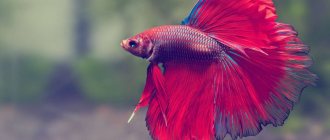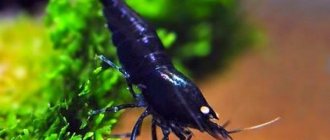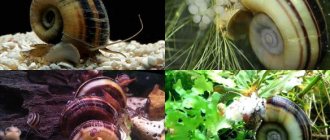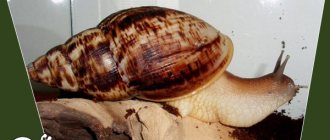Achatina immaculata is one of the three most popular species of snails grown at home. It is loved by many snail breeders for its beautiful shell and ease of care and maintenance. “Immaculata” translated means pure, unsullied. It received this name because of the species’ amazing ability to self-fertilize.
It was first discovered in the rain forests of Tanzania by the French biologist J. Lamarck in 1822. Immaculata are native to the forests and coastal zones of East Africa. In nature, it plays the role of orderlies, eating decaying and soft parts of plants, as well as the remains of dead animals. The local population of Africa eats Achatina; snail meat is low in calories and consists of 70% protein. A new trend in cosmetology is gaining great popularity - snail therapy at home, after several procedures wrinkles are smoothed out and pigment spots on the face go away.
Description of Achatina immaculata
An adult snail can reach 18 cm in length. The shell is cone-shaped with plump coils. The color of the shell is light with beige, dark brown and red stripes. In young immaculates, the shell color is variegated, and the color of the stripes is rich and bright. Over the years, the shell darkens, acquiring more shades of brown and black. Columella is pink or crimson in color. A pointed apex of beige or sand color crowns the clam shell. The body of the snail is more massive than that of the fulik, gray or beige in color with a smooth mesh pattern. Achatina immaculata is distinguished from other species of Achatina snails by a smooth dark brown stripe from the head to the shell. Albino forms are rare, with a few cases described in the literature.
What are the benefits of snails for humans?
The secretion secreted by Achatina has a lot of useful qualities. Its effect on the human dermis is used to treat certain diseases.
How is Achatina used in cosmetology?
Achatina are the only species of giant mollusks that are used in cosmetology. Using their secret, the following procedures are performed:
- skin rejuvenation;
- removal of scars;
- reducing the number of wrinkles;
- getting rid of skin diseases;
- regeneration and moisturizing of the skin;
- lightening pigmentation.
The mucus secreted by the snail helps fight peeling, various inflammations and acne.
Snail mucin (in creams, serums, gels, masks); effect on skin
The secret of Achatina is included in many cosmetic products. This active use is determined by its unique components:
- collagen – maintains skin firmness and its natural elasticity;
- allantoin – promotes the regeneration process;
- elastin – maintains the smoothness of the dermis;
- peptides – protect against harmful bacteria;
- vitamins A, B, E, C;
- glycolic acid – removes impurities and dead cells;
- lectins – act as a cleansing agent.
Mucin has a positive effect not only on the surface of the skin, but also on its deeper layers.
Achatina massage
With the help of snail massage, skin elasticity is restored and lymph flow is stimulated. The wave-like movements produced by the mollusks help improve blood flow. The duration of such a procedure is up to 30 minutes.
Cosmetological facial massage with Achatina snails
Subspecies of Achatina immaculata
The immaculate species includes three main subspecies, which are successfully propagated and grown at home around the world.
Achatina immaculata panthera
Characterized by a variegated and bright shell. The body of the Achatina panther is massive, with a dim mesh pattern of beige or gray color. The snail is unpretentious in care and food. Easily reproduces in captivity, producing a large number of viable offspring. Panther mucus is used for anti-aging and moisturizing masks that are prepared at home.
Achatina immaculata "two-tone"
An unusual and rare snail, characterized by the beautiful color of its shell, which appears to be divided into two parts. The two-colored Achatina was brought to our country from Germany, but due to the long journey and capricious nature, the mollusks did not take root and died. The two-color immaculata is demanding on temperature and humidity in the terrarium and goes into hibernation with small changes.
Achatina immaculata lamarckiana
Achatina Lamarckiana was brought to Russia and the CIS countries from England. Among our snail breeders, it was called Achatina Shtulman. The snail is undemanding in care and reproduces well in captivity. Shellfish meat and eggs are eaten as an unusual and nutritious delicacy.
Features of keeping the Achatina snail
At home, caring for mollusks is quite simple, since they are very unpretentious. To keep them, it is not necessary to buy a special terrarium; you can use a regular, even old, aquarium or a plexiglass structure.
Arrangement of the house
The volume of a terrarium or aquarium is selected at the rate of ten liters per snail .
To prevent your pet from traveling, it must be covered with glass on top. At the same time, gaps must be left between the roof and the housing body so that fresh air can enter the snail house. The bottom of the aquarium is covered with soil 5-10 cm thick. Peat without fertilizers sold in flower shops or coconut substrate, which can be bought at a pet store, are suitable for this purpose. You cannot use flower soil to keep snails at home, as it may contain chemicals and sawdust. Forest or garden soil can be used, but it must first be disinfected by boiling. The soil will maintain optimal humidity in your pet's home, so it needs to be moistened regularly. It also plays the role of a soft bedding that will prevent the mollusk from breaking when falling from the walls of the aquarium.
Snails love to swim , for which you need to place a container of water in their house, which will need to be changed regularly. It is best to choose a shallow cup so that your pet does not accidentally choke. You can place various shelters in the aquarium in the form of large stones, various driftwood, coconut shells, halves of flower pots. During daylight hours and in bright lighting, Achatina prefers to hide.
The air temperature for snails should be from 24C to 27C . If the room temperature at home is lower, you can increase it using a dimly lit lamp. Achatina live well even at lower temperatures, however, they move very slowly.
The required air humidity can be determined by the behavior of the mollusk. If he tries to clog himself in the shell, then the terrarium is too dry, and if the pet hangs on the walls all the time, it is too humid. By turning on the lighting and increasing the gap between the roof and the walls of the aquarium, you can dry the air. To increase humidity, it is enough to spray the soil or walls of your home with water.
What to feed the big Achatina?
When caring for snails, you should know what mollusks like and what to feed them. Each pet is individual and has its own gastronomic preferences. You will have to identify them experimentally. But the main diet of large snails must include greens, fruits and vegetables. Under natural conditions, Achatina even eat meat.
for feeding shellfish :
- Greens: alfalfa, plantain, yarrow, dandelion, sprouted oats, inflorescences of fruit trees and elderberries, nettles, daisies, clover, meadow plants.
- Vegetables: cabbage, spinach, cucumbers, celery, zucchini, lettuce, tomatoes, rutabaga, carrots, pumpkin, broccoli.
- Berries and fruits: grapes, melon, pears, strawberries, bananas, avocados, mangoes, pineapple, plums, figs, watermelon, apricots, strawberries, cherries, apples.
- Peas and legumes.
- Other types of products in the form of gammarus, baby food, boiled eggs, champignons, low-fat minced meat, fermented milk products, softened bread.
All greenery intended for feeding snails should be picked as far as possible from the city and highways.
Achatina cannot be fed:
- sour foods;
- sweets;
- pasta;
- smoked and fried foods;
- spicy and salty foods.
The pet's diet should be balanced and contain vitamins and minerals. In order for a snail to form a shell, it needs calcium. A soft or deformed shell indicates a lack of this mineral in the diet. There is a large amount of calcium in gammarus, eggshells, feed chalk, and shell rock.
Based on various elements, you can prepare a special mixture , the use of which will give quick results. This mixture includes:
- grain mixture consisting of wheat, barley, oats, flax seeds, millet – 70%;
- tricalcium phosphate – 12%;
- fish food – 5%;
- wheat bran – 5%;
- eggshells – 3%;
- gammarus – 5%.
Young snails need to be fed daily. It is recommended to give food in the evenings, as shellfish eat at night. Adult pets can be given food once every two to three days . We must not forget about drinking water for snails, which they need to secrete mucus.
Immaculate content
Achatina immaculata is an African snail that feels comfortable at 25-27 degrees and humidity 80-90%. You can artificially recreate such living conditions in a terrarium, food container or old rectangular aquarium. It is important to remember that the snail should not be cramped in the house you offer. The volume for one adult snail is 15 liters. Read more about arrangement and decoration here. Place the container with Achatina away from drafts and heating appliances.
A thermal cord or an ordinary light bulb helps maintain the temperature in the terrarium. Particular attention should be paid to choosing the right soil. The snail eats it, sleeps in the soil during the daytime and lays eggs in it. To maintain moisture, the litter is irrigated with warm water or a shallow pool is placed. Achatina immaculata loves when there are dry and damp places in the terrarium. Therefore, you should not over-moisten the soil.
Features of character and lifestyle
Photo: African snail Achatina
Snails are very calm creatures leading a quiet existence. In the wild they live alone, or they form a pair and live together in the same territory. They cannot exist in the form of a herd for a long time; a large concentration of adults leads to stress. Therefore, during overpopulation and a sharp surge in population growth, mass migration of Achatina may begin.
Achatina are active after rain and at night. During the day, these mollusks come out of hiding only when it is humid outside. On sunny days, snails hide behind stones, among the roots of trees and in thickets of bushes from the sunlight. They often bury themselves in the soil to avoid overheating. Young snails can move quite long distances and are not tied to resting places. Older individuals are more conservative and for recreation they arrange a certain place for themselves to rest and look for food for themselves near this place, trying not to move more than 5 meters away from it. Moving very slowly, Achatina crawls an average of 1-2 cm in one minute.
In the wild, with the onset of unfavorable living conditions, Achatina burrows into the ground, covers the gap in the shell with a special adhesive film of mucus and hibernates. It should be noted that hibernation is more of a protective mechanism; the snail does not need sleep, it does this in order to wait out unfavorable environmental conditions. Domestic snails can also hibernate if kept in poor conditions. This usually happens when the snail does not have enough food, or its nutrition is unbalanced, if the air in the terrarium is too dry, if the pet is cold, or is stressed.
It should be noted that long hibernation is not good for mollusks. During sleep, the snail loses a lot of weight; in addition, during prolonged sleep, at the entrance to the shell, in addition to the first film with which the snail closes its shell, more similar films of mucus are formed. And the longer the snail sleeps, the more difficult it is to wake it up. To wake up a snail after sleep, you just need to hold it under a stream of warm water and after a while the snail will wake up and get out of its house. When waking up, provide the snail with good conditions and increased nutrition.
Snail care
Even a child can take care of Achatina. Every morning, remove excrement and uneaten pieces of food, wash the bowl and drinking bowl. Do not place food on the ground; use a bowl or plastic lid. Rinse the soil once a week and add new soil. Perform general cleaning with complete replacement of litter, renewal of branches and snags no more than once a month. Snails love to swim, but you can’t bathe them under a tap; read how to do it correctly here. Wipe the immaculate sink with natural vegetable oil.
Story
Achatina is the largest species of terrestrial mollusks. The size of the shell reaches 25 cm, and the body size up to 30 cm. There are two pairs of horns on the head, which are used for touch. At the end of a long pair of horns there are eyes that funnily retract into the horns. The weight of an adult Achatina can reach several hundred grams. Its original habitat was East Africa, then it slowly moved to Madagascar and the Seychelles. In 1910 it was discovered in Sri Lanka and India, and in 1920 it became known in Malaysia, Indochina, Taiwan and various Pacific islands. When the number of this snail increased sharply, the local population began to experience considerable difficulties in fighting it. Although not definitively proven, it is believed that the Japanese army brought this snail from the South Pacific islands, where it was used as food, to their homeland after World War II. The Japanese also began to use it for food. However, in East Africa, these snails do not cause such problems, since another snail, Gonaxis, lives there, which is a natural enemy of Achatina, and keeps its numbers low. Also, there used to be a belief that soup made from this snail was a cure for tuberculosis, so it was specially brought to India, Singapore, California, and many tropical islands. In the USA, Akhatina is a national disaster. Somehow several snails found their way to Florida, and in just a year the cute little snails multiplied so much that they destroyed everything in the state - crops, bark on trees, and even plaster on houses! It's no joke about the plaster - to build shells, snails need calcium, and they got it by licking the facades of houses. Since then, all Achatina that come to the United States are given the death penalty, and lovers of these animals are given 5 years in prison. Fortunately, in our climate, Achatinas do not survive as wild animals, and keeping them in captivity is not dangerous. You can purchase Akhatin in our city. Usually they buy several individuals at once, but it is quite possible to take one. The cost of a snail is 1500 tenge. When purchasing more than three snails – 1,000 tenge. To purchase snails in Petropavlovsk, call: 8 (7152) 49-04-57, cell. 8-777-384-25-92, delivery possible.
Feeding Achatina immaculata
At home, the mollusk is fed with vegetables, herbs and fruits. To grow a large snail, you need to feed it with nutritious supplements, which can easily be prepared at home according to a recipe. They are convenient because they can be prepared for several months and only sprinkled on the uliam every evening. They include vegetable protein (cereals, seeds, mushrooms, etc.), and animal protein (gammarus, fish food, daphnia). Also, feeding does not contribute to the breeding of fruit midges in the terrarium, which is sometimes difficult to get rid of.
See more similar articles:
Large African snail - Achatina Fulica (Achatina...
Achatina - African giant snail
Back Forward 1 of 6
The third component of Achatina’s daily diet is calcium. If there is not enough of it in the mollusk’s body, growth and development stops, and the immaculate begins to gnaw on its own shell or the shells of its fellows. Calcium mixtures should always be in the snail's feeder. But not all products are allowed immaculately. Salt, sugar, semolina and flour are certain death for her. We have written an article with a table about permitted and prohibited snail products.
Feeding small Achatina immaculates
After hatching from the eggs, the babies eat the remains of their eggshells. Additionally, they are given grated vegetables, finely chopped greens and lettuce leaves generously sprinkled with edible chalk or ground eggshells. In the first days of life, babies require additional care and attention. By one month, the daily diet of young immaculates is no different from adults. Once a week, for rapid growth, they need to be pampered with nutritious treats prepared with their own hands.
What does the Achatina snail eat?
Photo: Large snail Achatina
Akhetines are herbivorous mollusks that feed on green vegetation, vegetables and fruits.
The diet of Achatina snails includes:
- sugar cane;
- tree buds;
- decaying plant parts;
- spoiled fruits;
- fruit tree leaves;
- grape leaves, lettuce;
- clover;
- dandelions;
- plantain;
- alfalfa;
- nettle;
- fruits (such as avocados, grapes, pineapple, mango, cherries, apricots, pears, apples);
- vegetables (carrots, cabbage, zucchini, beets, pumpkin, lettuce);
- bark of trees and shrubs.
Reproduction of Achatina immaculata
The white spot behind the eye on the right side is the genital opening. When you see something sticking out here, it's the snail's sex organ.
Immaculata, like all Achatina, is a hermaphrodite; it has male and female reproductive cells. Cases of snail self-fertilization have also been described. It reaches sexual maturity at 5-6 months, as evidenced by the appearance of a white tubercle on the right side of the mollusk’s neck. Achatina's love games last from 2 to 7 hours. Sperm remains in the body of the mollusk for two years. During this time, each mollusk lays 3-4 clutches per year.
10 days after mating, the immaculate lays 100-150 milky oval eggs, 5-6 mm in diameter, into the ground. To obtain offspring, the clutch is transferred to another container, where it is cared for and monitored. If you are not breeding snails, then it is better to freeze the clutch or prepare an unusual dish from it - snail caviar.
In terms of taste, it is not inferior to fish caviar.
Small snails are born after two weeks. The babies eat well and a lot, so they are fed 2-3 times a day. During the first month of an immaculate's life, with a balanced diet, it can grow 2 cm in length.
Appearance and features
Photo: What does the Achatina snail look like?
Achatina are large terrestrial gastropods. The shell size of an adult is from 10 to 25 cm in length. The weight of the snail is about 250-300 grams. Under favorable conditions, the weight of the mollusk can reach 400 grams. The body is plastic, up to 16 cm in length, completely covered with a pattern of small wrinkles. The structure of the snail is conventionally divided into two functional parts: the cephalopodium—the head and leg of the mollusk—and the visceropallium (torso).
The head of the mollusk is quite large, located in the front of the body. The head has small horns, cerebral ganglia, eyes and a mouth. The snail's eyes are located at the ends of the tentacles. Snails see poorly. They can only distinguish the shapes of objects at a distance of 1 cm from the eyes. Able to distinguish between light intensity. They really don't like bright light. If sunlight hits the snail, the mollusk begins to hide. The oral cavity is well developed. Inside there is a tongue with spikes on it. Thanks to this structural feature, the snail can easily capture food with its tongue.
Interesting fact: Snails of this species have as many as 25 thousand teeth. The teeth are strong and made of chitin. With the help of teeth, the snail grinds hard pieces of food.
The snail's foot is strong, with a large wrinkled sole, with the help of which the snail can move along both horizontal and vertical surfaces. The glands of the snail secrete special mucus, which promotes gliding and better suction to the surface. The inner bag is protected by a strong shell. The snail has a fairly simple internal structure of organs: a heart, a lung and one kidney. The heart consists of the left atrium and ventricle surrounded by the pericardium. The blood is clear. The snail breathes air through its lungs and skin.
The shell of the mollusk is strong and durable. The number of turns corresponds to the age of the mollusk. The shell color of even mollusks of the same subspecies can vary greatly. The color of the shell depends on the snail’s diet and the conditions in which the individual lives. The average lifespan of these mollusks in the wild is 11 years; in captivity, these creatures can live much longer.
Interesting fact: Achatina, like many other snails, have the ability to regenerate. That is, the snail is able to regrow the lost part of the body.
Interesting facts about Achatina immaculata
- Women of Egypt and Ancient Rome mined clay using immaculata shells to make dishes.
- Ancient craftsmen made bright jewelry from beautiful snail shells.
- Large shells of Achatina served as cups, and if the top was cut off, then as a drinking bowl for children, the sick and the elderly.
- Small shells were used to store tobacco, tea or spices, covering the hole with moss.
- Hippocrates used shellfish meat to treat tuberculosis, anemia and other diseases.
Origin and description
The natural habitat of the mollusk is hot Africa.
In the wild, snails grow rapidly.
Over the course of a year, their shell can increase in size up to 20 centimeters. The snail also has a rather large body, so in an apartment, exotic Achatina looks unusual and attracts the attention of everyone who comes.
All reticulata mollusks have the same shell. It is a beige shell with a ribbed surface, painted with brown stripes and spots. Differences are observed in body color; three types of Achatina reticulata are distinguished:
- Standard , which has a light body and a brownish head.
- Black-headed - here the name speaks for itself. The head of the mollusk is black, and the body has a white border.
- Albinos are mollusks completely devoid of pigment with a white head and body.
In addition to the reticulum, there are other types of Achatina snails :
- immaculata,
- albopicta,
- balteata,
- iradeli,
- fulika,
- marginata.
Each of them has slight differences in body structure, or the color of the flesh and shell. Some of the species are relatively new in domestic keeping, while others have been bred for quite a long time. They need the same conditions.
What to feed?
As already mentioned, the Achatina panther is nocturnal. It is at this time of day that snails begin to look for food. In their natural environment, they most often feed on grass, branches and animal remains. Panther snails have an excellent appetite, so they will happily eat any food.
Food should be given in the evening, after which the terrarium should be cleared of debris. Otherwise, uneaten food begins to disappear, which leads to the appearance of midges, unpleasant odors and mold.
At home, panthers should be fed the following nutrients:
- Calcium. It is obtained from edible chalk, eggshells, and sepia. Feeding calcium is necessary, since a lack of this element in the body will lead to the snail getting sick or eating the shells of its neighbors in the terrarium.
- Protein. Helps your Achatina grow faster and develop better. Pay attention to the protein dosage, otherwise you may poison your pet.
Food isn't the only thing snails love. They should be given fruits, vegetables and greens. Products must be pre-washed and cut into small pieces.
Newborn panthers should be given chopped vegetables, cabbage and lettuce. In addition, calcium must be included in the diet. Adult feeding may begin several weeks after birth.
Achatina albino as a pet
Snails are ideal pets for almost everyone. First of all, they are unusual animals. Secondly, snails are omnivorous and unpretentious in food and care. Thirdly, these are exotic pets.
Achatina albinos have no smell, do not make a sound, do not bite or scratch, and do not need to be walked or played with on a daily basis. Also, people are not allergic to them, so they are used in cosmetology - snail therapy.
Two-horned pets are perfect as pets for busy people and children, as they require a little of your attention and time. Mollusks have one vulnerable spot - the shell. If it is seriously damaged, the mollusk most often dies.











